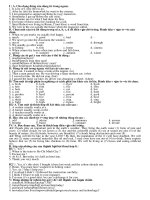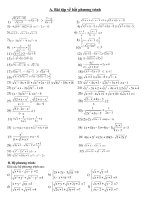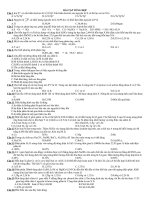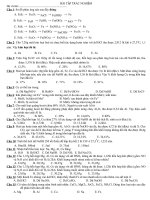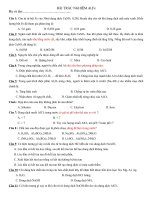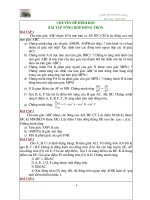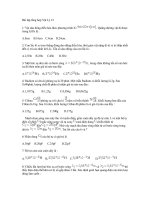Bài tập tổng hợp
Bạn đang xem bản rút gọn của tài liệu. Xem và tải ngay bản đầy đủ của tài liệu tại đây (216.89 KB, 5 trang )
<span class='text_page_counter'>(1)</span><div class='page_container' data-page=1>
O R I G I N A L A R T I C L E
Association of Three Plasmid-Encoded
spv
Genes Among
Different
Salmonella
Serotypes Isolated from Different Origins
Abdollah Derakhshandeh•<sub>Roya Firouzi</sub>•
Rahem Khoshbakht
Received: 30 July 2012 / Accepted: 2 October 2012 / Published online: 20 October 2012
ÓAssociation of Microbiologists of India 2012
Abstract The virulence plasmid associated Salmonella
plasmid virulence (spv) locus is strongly concomitant with
strains that cause non typhoid bacteremia. Thespvregion
contains three genes required for the virulence, the positive
transcriptional regulator spvR and two structural genes
spvBandspvC. The purpose of this study was to investigate
the presence of these three genes amongsalmonella
sero-types isolated from different sources. A collection of 60
salmonella serotypes from different sources were used.
Polymerase chain reaction was carried out for the presence
of these genes using specific primers. The prevalence of
spvB,spvC, andspvRgenes were 26 (43.3 %), 44 (73.3 %),
and 28 (46.6 %), respectively. The findings revealed that
the distribution of these genes was dissimilar among these
serotypes. Many of the human pathogenic salmonella
strains which can be transmitted by animals may have these
genes and can be very injurious for public health.
Keywords SpvgenesSalmonella serotypePCR
Introduction
During the last decades, the isolation of Salmonella has
been increased throughout the world [1]. Members of the
genusSalmonella infect a wide variety of hosts and cause
diseases in many animal species and in human beings
according to their antigenic profiles [2,3]. Salmonellosis is
associated with medium to severe morbidity and even
mortality in farm animals, representing major economic
losses in the food and animal industries [4]. Certain
serovars are particularly associated with systemic
infec-tions. A common feature of these serovars is the presence
of the plasmid-encoded spvgenes [5]. One main function
of the spv operon is to potentiate the systemic spread of
the pathogen [6]. The spv locus is strongly associated
with strains that cause non-typhoid bacteremia, but are not
present in typhoid strains, indicating that the pathogenesis
and immunology of typhoid have fundamental differences
from the syndrome of non-typhoid bacteremia [7]. Spv
genes are found in nearly all natural isolates ofSalmonella
that are host adapted to animals (Salmonella dublin, S.
choleraesuis,S. gallinarum-pullorum, and S. abortusovis)
but not in S. typhi. Plasmid-encoded spv genes are also
found in the common broad-host-range serovars, S.
ty-phimuriumandS. enteritidis, but only a variable proportion
of isolates carries these virulence plasmids [8]. The spv
locus consists of five genes, designated spvRABCD [9],
three of which are required for the virulence phenotype: the
positive transcriptional regulator spvR and two structural
genes spvB and spvC. The spvD gene is missing in the
chromosomal locus as found in serovar Arizona [10] and
it has been shown that the spvA gene is dispensable
for virulence in orally inoculated mice [11]. SpvB
pre-vents actin polymerization by ADP-ribosylation of actin
monomers. The C-terminal domain of SpvB contains
ADP-ribosyltransferase activity that covalently modifies G-actin
monomers and prevents their polymerization into F-actin
filaments [12]. Since F-actin is continuously formed and
depolymerized in the cell, the activity of SpvB in the host
cell cytoplasm leads to loss of the F-actin cytoskeleton
[13], furthermore, SpvB is required forSalmonella
prolif-eration in a subset of monocyte derived human
macro-phages, and is responsible for the late apoptosis seen
in host cells during Salmonella infection [14]. SpvC has
A. Derakhshandeh (&)R. FirouziR. Khoshbakht
Department of Pathobiology, School of Veterinary Medicine,
Shiraz University, Shiraz, Iran
</div>
<span class='text_page_counter'>(2)</span><div class='page_container' data-page=2>
been shown to have phosphothreoninelyase activity that
irreversibly inactivates host cell MAPkinases by removal
of phosphate and modification of the target threonine
[15]. The role of this activity in the virulence phenotype of
SpvC has not been determined. Both SpvB and SpvC
are translocated by the SPI-2 TTSS [16].spvR encodes a
MetR/LysR-type transcriptional activator and is transcribed
separately from the spvABCD structural genes. SpvR
binds to both thespvRandspvApromoters and is required
for expression of thespvABCDgenes [17]. The spvgenes
from different serovars are highly homologous [8] and
allow us to decide whether the pathogenesis of the isolates
from positive clinical samples is attributable to
chromo-some or plasmid born virulence factor [18]. The present
study aimed to investigate the prevalence of two main
virulence plasmid-born genes in spv locus, spvB, spvC
and regulator spvR gene and their association among
different serovars of Salmonella enterica isolated from
human and animals.
Materials and Methods
Bacterial Strains
A total of 60 Salmonella strains were recovered from
specimens submitted to the diagnostic microbiology
labo-ratory of the School of Veterinary Medicine between 2004
and 2005 in different outbreaks or individual cases in
Shiraz, Iran. Human fecal isolates derived from patients
with gastroenteritis were obtained from a diagnostic
labo-ratory in Shiraz, Iran. Strains which were previously
identified by conventional methods and serotyped by the
Salmonellareference center are listed in Table2.
DNA Preparation
A loopful of colonies of each isolate on agar plate was picked
and suspended in 200lL of distilled water. After vortexing,
the suspension was boiled for 5 min, and 50lL of the
supernatant was collected after spinning at 14,000 rpm for
10 min. The DNA concentration of the boiled extracts was
determined with spectrophotometer [19].
PCR Assay
PCR amplifications were performed in a final volume
of 25lL in PCR tubes. The reaction mixtures consisted
of 2lL of the DNA template, 2.5lL 109 PCR buffer
(75 mM Tris–HCl, pH 9.0, 2 mM MgCl2, 50 mM KCl,
20 mM (NH4)2SO4), (CinaGen, Iran), 1lL dNTPs
(50lM), (CinaGen, Iran), 1lL (1U Ampli Taq DNA
polymerase), (CinaGen, Iran), 1lL (25 pmol) from the
forward and reverse primers (CinaGen, Iran), of both
pri-mer pairs (Table1) and the volume of the reaction mixture
was completed to 25lL using distilled deionized water.
The thermal cycler (MJ mini, BioRad, USA) was adjusted
under the following conditions: Initial denaturation at
94°C for 5 min, followed by 35 cycles of denaturation at
94°C for 1 min, annealing as shown in Table1for 1 min
and extension at 72°C for 1 min. Final extension was
carried out at 72°C for 10 min and the PCR products were
stored in the thermal cycler at 4°C until they were
col-lected. Amplified products were separated by
electropho-resis in 1.5 % agarose gel stained with ethidium bromide.
Visualization was undertaken using a UV transilluminator
(BTS-20, Japan) and the 50 bp plus DNA ladder was used
as molecular size marker Fig.1.
Results
Among 60 differentsalmonellaisolates, the prevalence of
spvB,spvC, andspvRgenes were 26 (43.3 %), 44 (73.3 %),
and 28 (46.6 %), respectively. S. colindal detected from
poultry andS.Virchowobtained from animals did not show
the presence of these virulence genes. Furthermore, 14
ser-otypes (fourS.enteritidisand twoS.typhimuriumisolated
from poultry and fiveS.abortusovis, twoS.typhimurium, and
oneS.enteritidisdetected from animals) were positive for
occurrence of these three virulence genes concurrently. All
strains withspvRgene had one or both of the otherspvgenes.
Just oneS.infantisisolated from poultry had bothspvBand
spvCgenes, while four other analogous strains did not have
these genes. The detailed results of PCR detection of three
spvvirulence genes in differentSalmonellaserotypes with
various sources are presented in Table2.
Discussion
</div>
<span class='text_page_counter'>(3)</span><div class='page_container' data-page=3>
that encode the spv operon, indicating that spv genes are
not required to cause gastroenteritis in people [7]. Few
studies have been conducted on the prevalence of these
genes in different serovars ofSalmonellain all parts of the
world, especially in Iran [26, 27]. This study is the first
report of distribution ofspvB,spvCgenes inS. abortusovis
andS.infantisisolated from animals and poultry in Iran. In
epidemiologically unrelated isolates from different states
in the United States, 76 % of the blood isolates carriedspv
genes, about twice the percentage of fecal isolates [7]. In
the present study, the prevalence of these three genes,
spvB, spvC and spvR in all of the salmonella serotypes
were 43.3 % (26/60), 73.3 % (44/60) and 46.6 % (28/60)
respectively. Zahraei et al. [27] revealed that spvB and
spvC genes were present in 90 % of the isolates (18/20).
They reported that the prevalence of these genes in poultry
and bovine S. enteritidis isolates were 88.6 and 100 %
respectively, while in the present study the presence of
spvBandspvCgenes in poultry isolatedS.enteritidiswas
46.6 % (7/15) and 93.3 % (14/15) respectively. Another
Table 1 Nucleotide sequences used as primers in the PCR reaction for threespvgenes inSalmonellaserotypes
Name of primer Sequence (50–30) Target gene Annealing temperature Product size (bp) References
spvC1 CGGAAATACCATCTACAAATA spvC 42°C 669 [20]
spvC2 CCCAAACCCATACTTACTCTG
spvBF ATGTTGATACTAAATGGTTTTTCA spvB 55°C 1,776 [21]
spvBR CTATGAGTTGAGTACCCTCATGTT
spvRF ATGGATTTCATTAATAAAAAATTA spvR 55°C 894 [21]
spvRR TCAGAAGGTGGACTGTTTCAGTTT
Table 2 Prevalence ofspvB,
spvCandspvRgenes in
Salmonellaserotypes
Source/serotype No. of isolates No. (%) positive for virulence genes
spvB spvC spvR
Poultry
S. Enteritidis 15 7 (46.6) 14 (93.3) 9 (60)
S. Typhimurium 9 2 (22.2) 7 (77.7) 4 (44.4)
S. Infantis 5 1 (20) 1 (20) 0 (0)
S. Colindal 1 0 (0) 0 (0) 0 (0)
Animals
S. Abortusovis 12 8 (66.6) 10 (83.3) 7 (58.3)
S. Enteritidis 7 2 (28.5) 6 (85.7) 3 (42.8)
S. Typhimurium 5 5 (100) 3 (60) 3 (60)
S. Virchow 1 0 (0) 0 (0) 0 (0)
Human
S. Enteritidis 3 0 (0) 3 (100) 2 (66.6)
S. Bardo 2 1 (50) 0 (0) 0 (0)
Total 60 26 (43.3) 44 (73.3) 28 (46.6)
Fig. 1 Agarose gel electrophoresis of PCR product of three spv
</div>
<span class='text_page_counter'>(4)</span><div class='page_container' data-page=4>
study has reported the lack ofspvCgene in 7.2 % (8/110)
of theS. enteritidissamples from human, pig, and poultry
sources [28]. Zahraei et al. [27] showed that thespvgenes
were not detected in 5.9 % of isolates of theS. enteritidis
as compared with 7.4 % of the isolates reported by Pan and
Liu [29]. A study reported in 2000 has shown that among a
total of 17 isolates ofS. enteritidisandS. typhimurium,all
samples possessed spvC [30]. Ling [31] analyzed 152
isolates ofS. enteritidisfrom human feces in which only 4
isolates (8 %) lackedspvC. Although, Zahraei et al. [27],
have proposed the increase inspvgenes inS. enteritidisin
recent years these prevalence diversities of one gene may
be due to genetic differences between strains from different
geographic areas. Findings showed that, among animal
S.enteritidisisolates, 28.57 % (2/7) and 85.7 % (6/7) had
spvBandspvCvirulence genes, respectively. Prevalence of
spvRgene in poultry and animalS.enteritidisisolates was
60 % (9/15) and 42.8 % (3/7) respectively and 46.6 % (28/
60) in total of strains, which is against the results of Bacci
et al. [32] that showed 100 % presence of spvR gene in
different serovars. They reported that some
plasmid-nega-tive strains hadspvgenes, and which be due to the creation
of episome mode [32]. Unlike them, we suggested that the
lack of somespv genes insalmonella serotypes could be
due to the existence of incompletespv locus, rather than
the transfer of genes into the chromosomal DNA. Among
twelve S. abortusovis serovars studied in this study,
dis-tribution ofspvB,spvCandspvRgenes was 66.6, 83.3 and
53.3 % respectively and 41.6 % (5/12) of them had three
spv genes simultaneously, which may increase the
pro-pensity of these strains to be of major clinical relevance
in coordination with the results of Gebreyes et al. [33].
Furthermore, all 28 strains withspvRgene simultaneously
had one or both of the otherspvgenes. Although spvR is a
positive transcriptional regulator ofspvABCD, it seems that
these serovars could express their related spv genes and
may be more virulent in pathogenicity [8].S. colindaland
S.virchow serotype in the present study did not show the
presence ofspvgenes. To clarify the subject, more
inves-tigations are proposed for the presence or absence ofspv
locus genes in these serovars. One of twoS.bardoisolated
from human showed only the presence of spvB gene. In
addition, three human S. enteritis serovars did not have
spvBgene, but two of them indicated concurrent presence
of spvC and spvR. However, one out of five S. infantis
strains obtained from poultry had both spvB and spvC
genes and neither hadspvRgene. The evidence taken from
this study confirms the results of other studies which show
a higher distribution for the virulence plasmid from
animal-origin isolates than that of human-animal-origin [26, 27]. The
findings of the present study suggest a dissimilar
distribu-tion of spvB, spvC and spvR genes among Salmonella
serotypes from different sources. Genetic variations in
Salmonellacould be derived from the transfer of virulence
plasmid from animal-origin strains to human-origin strains
or vice versa, which remains to be investigated. It is
becoming clear that epidemiological investigations about
bacterial virulence factor genes are essential to understand
the biology of bacterial abnormalities, rapid diagnosis of
infections, for treatment of their disorders and producing
ideal vaccines against them. Results demonstrated that the
prevalence of spv genes is different among various
sal-monella serovars. Strains isolated from animals showed a
higher prevalence of these genes.
Acknowledgments This work was supported by a Grant from
Shiraz University. The authors are grateful to Mr. Shahed for his
excellent technical assistance.
References
1. Madadgar O, Zahraei Salehi T, Tadjbaksh H, Mahzounieh M,
Feizabadi M (2008) Genomic and phenotypic evaluation of
Sal-monella typhimurium andSalmonella enteritidis in Iran. Comp
Clin Pathol 17:229–235
2. Coburn B, Grassl GA, Finlay BB (2007)Salmonella, the host and
disease: a brief review. Immunol Cell Biol 85:112–118
3. Ranjbar R, Giammanco GM, Aleo A, Plano MR, Naghoni A,
Owlia P, Mammina C (2010) Characterization of the first
extended—spectrum beta lactamase—producing nonthyphoidal
Salmonellastrains isolated in Tehran, Iran. Foodborne Pathog Dis
7(1):91–95
4. Malkawi HI, Gharaibeh R (2004) Rapid and simultaneous
Iden-tification of two Salmonella enterica serotypes Enteritidis and
Typhimurium from chicken and meat product by multiplex PCR.
Biotechnology 3(1):44–48
5. Guiney DG, Fang FC, Krause M, Libby SJ, Buchmeier N, Fierer J
(1995) Biology and clinical significance of virulence plasmids in
Salmonella. Clin Infect Dis 21:146–151
6. Heithoff DM, Shimp WR, lau PW, Badie G, Enioutina EY,
Daynes RA, Barbara RA, Byrne A, House J, Mahan MJ (2008)
HumanSalmonellaclinical isolates distinct from those of animal
origin. Appl Environ Microbiol 10:1757–1766
7. Guiney DG, Fierer J (2011) The role of thespvgenes in
Sal-monellapathogenesis. Front Microbiol 2(129):1–10
8. Libby SJ, Adams LG, Ficht TA, Allen C, Whitford HA,
Buc-hmeier NA, Bossie S, Guiney DG (1997) Thespvgenes on the
Salmonella Dublin virulence plasmid are required for severe
enteritis and systemic infection in the natural host. Infect Immun
65(5):1786–1792
9. Krause M, Fang FC, Guiney DG (1992) Regulation of plasmid
virulence gene expression in Salmonella dublin involves an
unusual operon structure. J Bacteriol 174:4482–4489
10. Libby SJ, Lesnick M, Hasegawa P, Kurth M, Belcher C, Fierer J,
Guiney DG (2002) Characterization of the spvlocus in
Salmo-nella entericaserovar Arizona. Infect Immun 70:3290–3294
11. Roudier C, Fierer J, Guiney DG (1992) Characterization of
translation termination mutations in thespvoperon of the
Sal-monellavirulence plasmid pSDL2. J Bacteriol 174:6418–6423
12. Hochmann H, Pust S, von Figura G, Aktories K, Barth H (2006)
</div>
<span class='text_page_counter'>(5)</span><div class='page_container' data-page=5>
13. Lesnick ML, Reiner NE, Fierer J, Guiney DG (2001) The
Sal-monella spvB virulence gene encodes an enzyme that ADP
ribosylates actin and destabilizes the cytoskeleton of eukaryotic
cells. Mol Microbiol 39:1464–1470
14. Paesold G, Guiney DG, Eckmann L, Kagnoff MF (2002) Genes
in the Salmonella pathogenicity island 2 and the Salmonella
virulence plasmid are essential forSalmonellainduced apoptosis
in intestinal epithelial cells. Cell Microbiol 4:771–781
15. Li H, Xu H, Zhou Y, Zhang J, Long C, Li S, Chen S, Zhou JM,
Shao F (2007) The phosphothreonine lyase activity of a bacterial
type III effector family. Science 315:1000–1003
16. Mazurkiewicz P, Thomas J, Thompson JA, Liu M, Arbibe L,
Sansonetti P, Holden DW (2008) SpvC is aSalmonellaeffector
with phosphothreoninelyase activity on host mitogen activated
protein kinases. Mol Microbiol 67:1371–1383
17. Grob P, Guiney DG (1996) In vitro binding of theSalmonella
dublinvirulence plasmid regulatory protein SpvR to the promoter
region ofspvAandspvR. J Bacteriol 178:1813–1820
18. Trafny EA, Kozlowska K, Szpakowska M (2006) A novel
Mul-tiplex PCR assay for the detection ofSalmonellaenteric serovar
Enteritidis in human faeces. Lett Appl Microbiol 43:673–679
19. Lin AW, Usera MA, Barrett TJ et al (1996) Application of
ran-dom amplified polymorphic DNA analysis to differentiate strains
of Salmonella enteritidis. J Clin Microbiol 34:870–876
20. Swamy SC, Barnhart H, Lee MD, Dreesen DW (1996) Virulence
determinantsinvA andspvC in Salmonellae isolated from poultry
products, wastewater, and human sources. Appl Environ
Micro-biol 62:3768–3771
21. Huang R, Wu S, Zhang X, Zhang Y (2005) Molecular analysis
and identification of virulence gene on pRST98 from multi-drug
resistantSalmonellatyphi. Cell Mol Immunol 2:136–140
22. Jones TF, Ingram LA, Cieslak PR, Vugia DJ, Tobin-D’Angelo M,
Hurd S, Medus C, Cronquist A, Angulo FJ (2008) Salmonellosis
outcomes differ substantially by serotype. J Infect Dis 198:109–114
23. Foley SL, Lynne AM (2008) Food animal associatedSalmonella
challenges: pathogenicity and antimicrobial resistance. J Anim
Sci 86:173–187
24. Clements M, Eriksson S, Tezcan-Merdol D, Hinton JCD, Rhen M
(2001) Virulence gene regulation inSalmonella enterica. Ann
Med 33:178–185
25. Fierer J, Guiney DG (2001) Diverse virulence traits underlying
different clinical outcomes ofSalmonellainfection. J Clin Invest
107:775–780
26. Del Cerro A, Soto SM, Mendoza MC (2003) Virulence and
antimicrobial-resistance gene profiles determined by PCR-based
procedures forSalmonellaisolated from samples of animal
ori-gin. Food Microbiol 20:431–436
27. Zahraei Salehi T, Amini K, Nikbakht G, Ranjbar R, Amini J,
Ashrafganjooei SB (2008) Molecular detection ofinvAandspv
virulence genes in Salmonella enteritidis isolated from human
and animals in Iran. Afr J Microbiol Res 4(21):2202–2210
28. Castilla KS, Ferreira CSA, Moreno AM, Nunes IA, Ferreira AJP
(2006) Distribution of virulence genes sefC, pefA and spvC in
Salmonella Enteritidis phage type 4 strains isolated in Brazil.
Braz J Microbiol 37(2):1–7
29. Pan TM, Liu YJ (2002) Identification ofSalmonellaEnteritidis
isolate by polymerase chain reaction and multiplex polymerase
chain reaction. J Microbiol Immuno Infect 35:147–151
30. Jenikova G, Pazlarova J, Demnerova K (2000) Detection of
Salmonellain food sample by the combination of
immunomag-netic separation and PCR assay. Int Microbiol 3:225–229
31. Ling JML (2009) Rapid detection of food-borne pathogens in
clinical specimens, food and environmental samples. Hong Kong
Med J 15(1):26–29
32. Bacci C, Paris A, Salsi A, Bonardi S, Brindani F (2005) Relation
between the presence of extrachromosomal DNA and virulence
features in Salmonella entericastrains. Ann Fac Medic Vet Di
Parma 25:175–180
</div>
<!--links-->

